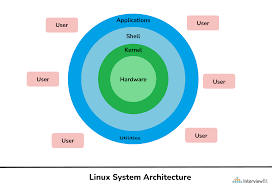What is the Linux system administration?
Linux system administration
Linux system administration is a process of setting up, configuring, and managing a computer system in a
Linux operating system
The Linux operating system was developed by Linus Torvalds in 1991. The Linux operating system is an open-sourced system software that manages the computer hardware resources and computing devices. The operating system manages the communication between your application software and hardware resources. Because it is an open source software, it allows the user to have access to its source code, give room for further modification, and allow for further distribution as received.The Linux family is called distribution (distro), whereas the Windows operating system is called version.
Components of Linux operating system
The Linux operating system contains the following components:
- Bootloader: This is a software that manages the boot process of your computer.
- Kernel: The kernel is also called the Linux kernel and is the system traffic controller that allocates system resources to the running application. Software applications request the kernel for hardware resources such as disc space, RAM, and CPU. Software applications use the
API Application Programming Interface - Init system: This is a subsystem that bootstraps the user space and controls daemons. The init system manages the boot process after it is handled by the bootloader.
- Daemons: Daemons are programs or drivers that manage underground applications like printing sounds, network, etc.
- Graphical server: The graphical server system supports the graphic display on the screen.
- Desktop environment: The desktop environment allows the user to interface with the operating system. The Linux OS offers a variety of desktop environments with their own built-in applications to choose from.
- Application: The desktop environment does not offer all of the applications a user might need, but Linux allows the user to install additional applications.
The Linux operating system is used as a client-side (desktop) and server-side operating system.
Linux operating system interface
The Linux operating system offers two types of user interface,
The Linux OS serves as the backbone for network infrastructure, Cloud computing, web servers, database servers, email servers, and directory service. Each of these servers and services requires a system administrator to manage them.
System administration is carried out by an expert in the IT (Information Technology) industry. The expert ensures that all computing devices and networks work properly. The job demand depends on the kind of system, software application, and work environment.
System administrator allows the administrator to allocate user privileges based on the required resources and function of the user. The system administrator is the most privileged user, known as the super user, and determines what computing resources each user receives.
Summary
In summary, Linux system administration is a process that involves managing, monitoring, installing, and documenting computer hardware and software procedures, and sets up measures for disaster recovery in a Linux environment.
